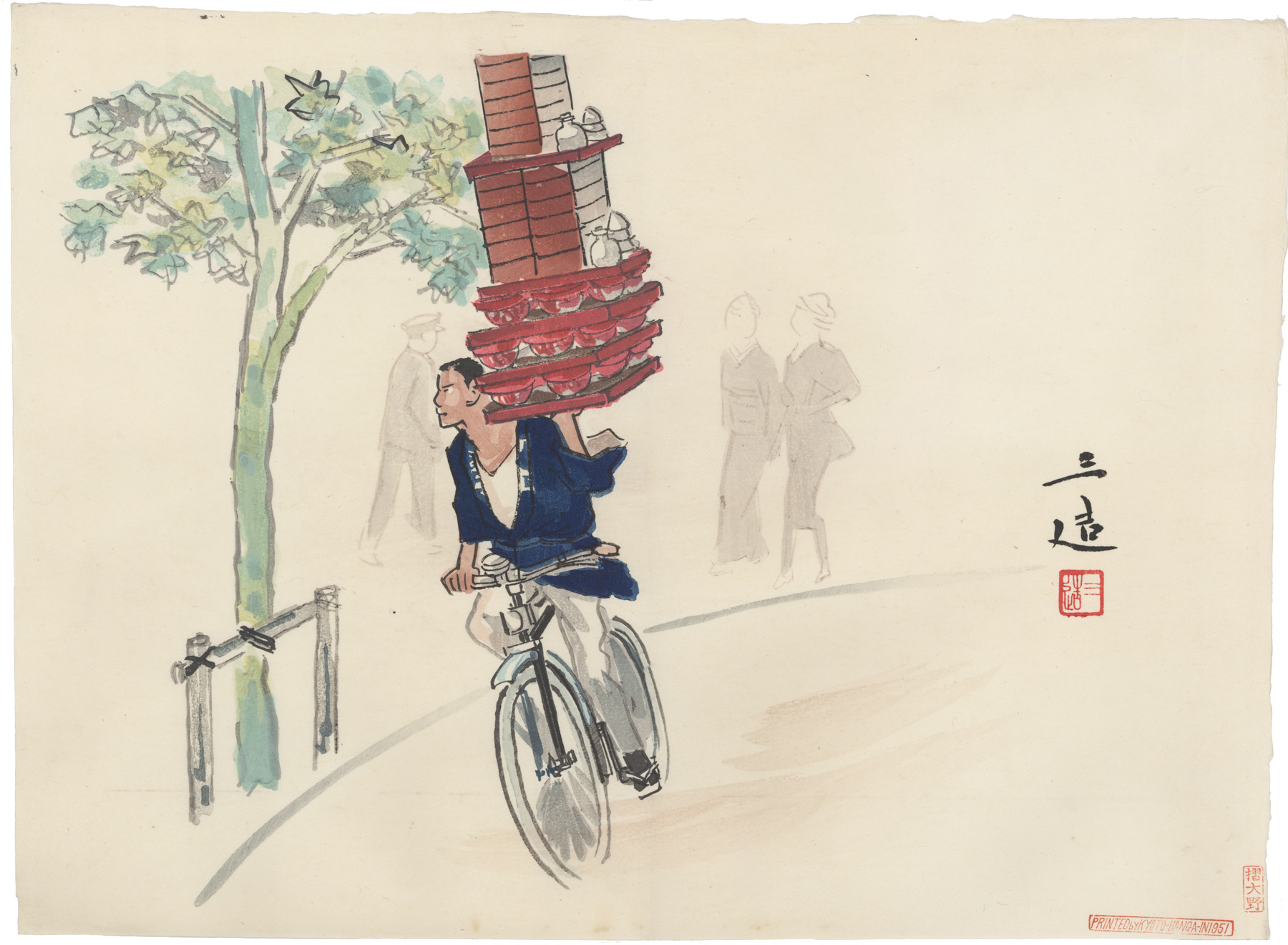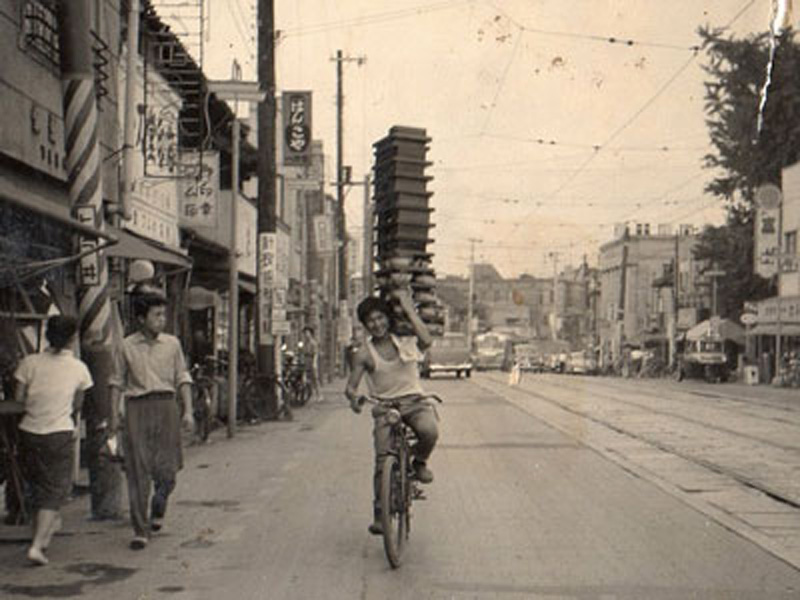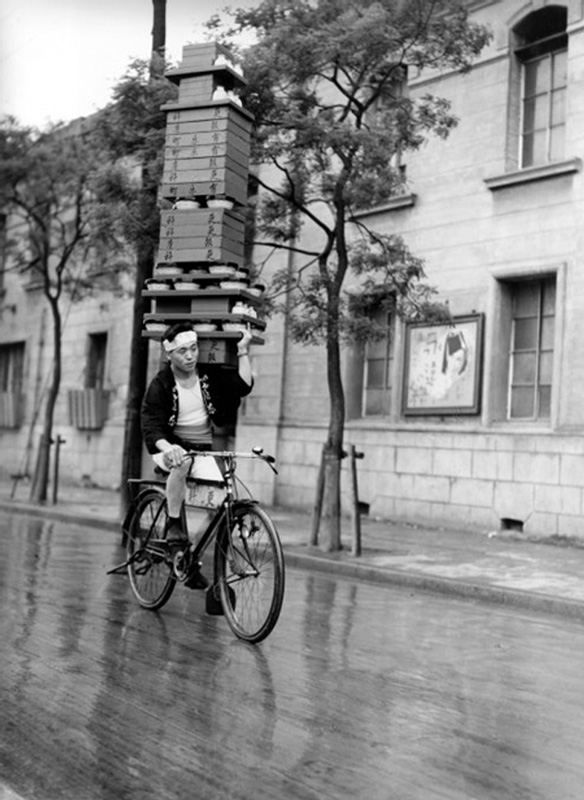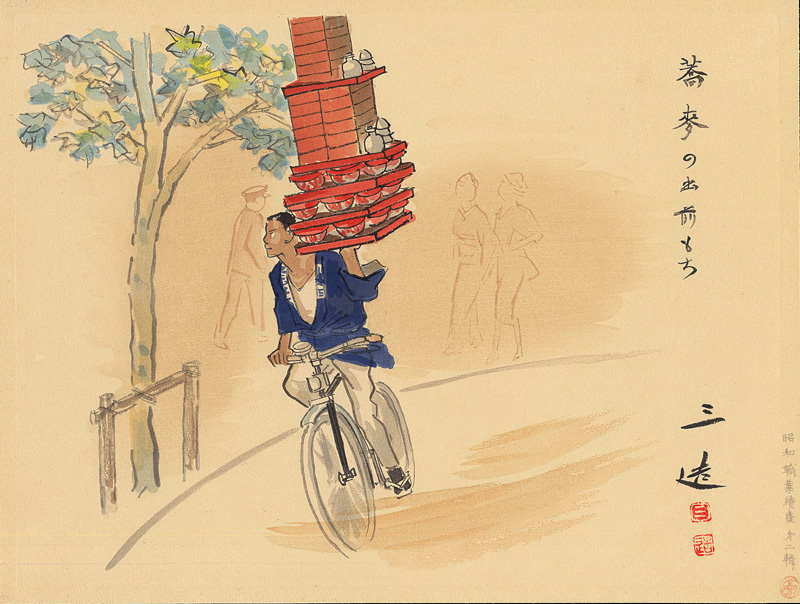About This Print
[First Edition, 1940, published by Nishinomiya Shoin] The Soba Deliveryman
Anyone will tell you that the soba delivery ma is a common sight in Tokyo. This, however, does not mean that they are transmitting the same vigorous Edo-style spirit of the fishsellers and firemen into the present, because rather a lot of them seem to come from rural areas. It is interesting to see that in spite of these differences they do wear the same style of clothes.
On his bicycle he flies along the wind, skillfully maneuvering between horses, cars, and pedestrians while carrying a tower piled high with steaming baskets and bowls, sometimes makes you sweat.
Because today's youth are discontinuing their patronage, the number of soba delivery men has greatly dwindled. Before long, will the scene in this image become just an old story?
As issued by the publisher Kyoto Hangain, the print was tipped into a paper display folder with the below commentary by the publisher pasted on the folder.
[Second Edition, c. 1950, published by Kyoto Hangain
A Delivery Boy
(Demai-mochi)The Japanese like "Soba" and "Udon" which are something like spaghetti and maccaroni [sic]. The udon shop delivers the dishes when ordered, and several kinds of containers are used.You see a delivery boy on his bicycle, holding a stock of bowls or trays, cases, sauce-bottles and cups with his left hand, and steering the bicycle with a single hand, just like trick-riding seen in the circus.Depicted by Sanzo Wada. Printed by KYOTO-HANGA-IN.
Two different states of the first edition published by Nishinomiya Shoin
Sources: website of Ross Walker Ohmi Gallery http://www.ohmigallery.com/DB/Artists/Sales/Wada_Sanzo.asp and website of USC Pacific Asian Museum "Exhibition - The Occupations of Shōwa Japan in Pictures: The Woodblock Prints of Wada Sanzō"
Note:
My special thanks to Shinagawa Daiwa, the current owner of Kyoto Hangain, for providing the below information (in a series of emails in July 2014) about Nishinomiya Shoin and Kyoto Hangain, both businesses started by his father Shinagawa Kyoomi. Shinagawa's current website can be accessed at http://www.amy.hi-ho.ne.jp/kyotohangain/
Wada’s major contribution as a woodblock print artist came through his 72 print 3-part series Occupations of Shōwa Japan in Pictures (Shōwa shokugyō e-zukishi), also translated as Occupations of the Shōwa Era in Pictures and Japanese Vocations in Pictures. The three part series was started during the Pacific War (1937-1945) in September 1938, was then interrupted by war shortages in 1943, and was restarted again after the war in January 1954. This series was a labor of love for Wada and he brought together woodblock print printers and carvers in Nishimomiya near Kobe to work on this project.
The war era prints were published by Wada through an old books store, Nishinomiya shoin 西宮書院 run by Shinagawa Kyoomi 品川清臣. Wada planned a total of 100 designs, with two prints being issued each month. Wada's designs for the prints were rendered in watercolor and the finished prints beautifully captured the look-and-feel of those original watercolors. The series was an immediate hit, but was suspended after 48 prints (issued in two series) in 1943 due to war shortages.
After the war, the series was continued by the same publisher, Shinagawa Kyoomi, who had opened a new business in Kyoto, which he named Kyoto Hangain 京都版画院. (Shingawa's business in Nishinomiya had burned down during WWII.) At first Kyoto Hangain published re-prints of the earlier prints, but they went on to publish a third series of 24 prints, working closely with Wada, titled Continuing Occupations of Shōwa Japan in Pictures between November 1954 and September 1956.1 The post-war prints were popular with the Occupation's "deep-pocketed" military and civilian personnel and the series was "featured in an article of the Tokyo edition of the United States military newspaper Stars and Stripes."2 Shinagawa also published a six print portfolio in the 1950s titled Japanese Life and Customs, consisting of six of the prints from the earlier two series in a reduced chuban size, which is also part of this collection.
Occupations of Shōwa Japan in Pictures has been praised for showing “the complexity of Shōwa society…. capture[ing] the pulse of Japanese life during the tumultuous decades of the 1930s, 1940s and 1950s”3 and condemned as providing a “visual message of subtle or blatant propaganda in support of government-sponsored ideas.”4
It is interesting to see how the commentary, written by the artist, that accompanied each print in the pre-war releases was softened for the post-war re-issues by Kyoto Hangain. All references to soldiers being away from home (as Japanese armies were marching through Asia when the series was originally released) or references to Imperial Japan have been stripped away and the commentary becomes innocent, folk-like and appealing to the post-war occupying forces. (For example, see the prints Women Weavers and Picture Card Show which provide the artist's original commentary and a full transcript of the English text attached to the folders of the post-war re-issued prints.)
3 "Out of the Dark Valley: Japanese Woodblock Prints and War, 1937-1945," Kendall H. Brown,p. 82 appearing in Impressions, The Journal of the Ukiyo-e Society of America, Inc., Number 23, 2001.
4 Pacific Asia Museum website http://www.pacificasiamuseum.org/_on_view/exhibitions/2004/occshowa.aspx
5 Light in Darkness: Women in Japanese Prints of Early Shōwa (1926-1945), Kendall H. Brown, et. al., Fisher Gallery, University of Southern California, 1996, p. 18.
| IHL Catalog | #1983 |
| Title/Description | 蕎麦の出前もち [Soba no demae-mochi] - Soba Deliveryman |
| Series | Occupations of Shōwa Japan in Pictures, Series 2 (also seen translated as "Compendium of Occupations in the Shōwa Era" and "Japanese Vocations in Pictures") Shōwa shokugyō e-zukushi 昭和職業繪盡 (also seen written as 昭和職業絵尽し and 昭和職業繪盡し), dainishū (第二輯) |
| Artist | Wada Sanzō (1883-1967) |
| Signature |  |
| Seal of Artist |  |
| Publication Date | 1951 (originally 1940/1941) |
| Publisher | Kyoto Hangain 京都版画院  |
| Edition | A second edition of the print first published by Nishinomiya shoin in 1940. It is believed that all the pre-WWII woodblocks for this series were destroyed in Allied air raids in 1945 and that all post-WWII impressions by Kyoto Hangain, were made from re-cut blocks. |
| Printer |  摺大野 suri [printer] Ono [likely Ono Chiyozō] 摺大野 suri [printer] Ono [likely Ono Chiyozō] |
| Impression | excellent |
| Colors | excellent |
| Condition | excellent - minor printer marks top margin and possible foxing bottom margin |
| Genre | shin hanga |
| Miscellaneous | |
| Format | dai-oban |
| H x W Paper | 11 1/2 x 15 7/8 in. (28.6 x 41.3 cm) |
| H x W Image | 10 1/4 x 13 1/4 in. (28.6 x 41.3 cm) [measurement includes signature and seal] |
| Collections This Print | Museum of Fine Arts, Boston 2015.3204; San Diego Museum of Art 1965.77.u; Art Gallery of Greater Victoria 1997.020,009 |
| Reference Literature | Memories of Shōwa: Impressions of Working Life by Wada Sanzō, Maureen de Vries and Daphne van der Molen, Nihon no hanga, 2021 |







